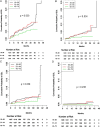Human papillomavirus virus (HPV) genotype- and age-specific analyses of external genital lesions among men in the HPV Infection in Men (HIM) Study
- PMID: 25344518
- PMCID: PMC4432433
- DOI: 10.1093/infdis/jiu587
Human papillomavirus virus (HPV) genotype- and age-specific analyses of external genital lesions among men in the HPV Infection in Men (HIM) Study
Abstract
Background: Human papillomavirus (HPV) causes external genital lesions (EGLs) in men, including condyloma and penile intraepithelial neoplasia (PeIN). We sought to determine the incidence of pathologically confirmed EGLs, by lesion type, among men in different age groups and to evaluate the HPV types that were associated with EGL development.
Methods: HPV Infection in Men (HIM) study participants who contributed ≥2 visits from 2009-2013 were included in the biopsy cohort. Genotyping by an HPV line-probe assay was performed on all pathologically confirmed EGLs. Age-specific analyses were conducted for incident EGLs, with Kaplan-Meier estimation of cumulative incidence.
Results: This biopsy cohort included 2754 men (median follow-up duration, 12.4 months [interquartile range, 6.9-19.2 months]). EGLs (n = 377) were pathologically confirmed in 228 men, 198 of whom had incident EGLs. The cumulative incidence of any EGL was highest among men <45 years old and, for condyloma, decreased significantly over time with age. The genotype-specific incidence of EGL varied by pathological diagnoses, with high- and low-risk genotypes found in 15.6% and 73.2% of EGLs, respectively. Condyloma primarily contained HPV 6 or 11. While PeIN lesions primarily contained HPV 16, 1 PeIN III lesion was positive for HPV 6 only.
Conclusion: Low- and high-risk HPV genotypes contribute to the EGL burden. Men remain susceptible to HPV-related EGLs throughout the life span, making it necessary to ensure the longevity of immune protection against the most common causative HPV genotypes.
Keywords: HIM Study; age; condyloma; external genital lesions; genotype; human papillomavirus (HPV); penile intraepithelial neoplasia (PeIN).
© The Author 2014. Published by Oxford University Press on behalf of the Infectious Diseases Society of America. All rights reserved. For Permissions, please e-mail: journals.permissions@oup.com.
Figures

Comment in
-
Re: Human Papillomavirus (HPV) Genotype- and Age-Specific Analyses of External Genital Lesions among Men in the HPV Infection in Men (HIM) Study.J Urol. 2015 Aug;194(2):334-5. doi: 10.1016/j.juro.2015.05.010. Epub 2015 May 12. J Urol. 2015. PMID: 26195360 No abstract available.
Similar articles
-
Genital Human Papillomavirus Infection Progression to External Genital Lesions: The HIM Study.Eur Urol. 2016 Jan;69(1):166-73. doi: 10.1016/j.eururo.2015.05.032. Epub 2015 Jun 6. Eur Urol. 2016. PMID: 26051441 Free PMC article.
-
HPV-related external genital lesions among men residing in Brazil.Braz J Infect Dis. 2017 Jul-Aug;21(4):376-385. doi: 10.1016/j.bjid.2017.03.004. Epub 2017 Apr 8. Braz J Infect Dis. 2017. PMID: 28399426 Free PMC article.
-
Seroprevalence of Cutaneous Human Papillomaviruses and the Risk of External Genital Lesions in Men: A Nested Case-Control Study.PLoS One. 2016 Nov 28;11(11):e0167174. doi: 10.1371/journal.pone.0167174. eCollection 2016. PLoS One. 2016. PMID: 27893841 Free PMC article.
-
Chapter 4: Burden and management of non-cancerous HPV-related conditions: HPV-6/11 disease.Vaccine. 2006 Aug 31;24 Suppl 3:S3/35-41. doi: 10.1016/j.vaccine.2006.06.015. Vaccine. 2006. PMID: 16950016 Review.
-
Human papillomavirus and genital cancer.Indian J Dermatol Venereol Leprol. 2009 May-Jun;75(3):236-43; quiz 243-4. doi: 10.4103/0378-6323.48429. Indian J Dermatol Venereol Leprol. 2009. PMID: 19439875 Review.
Cited by
-
Prevalence and distribution of HPV types in genital warts in Xi'an, China: a prospective study.BMJ Open. 2019 May 14;9(5):e023897. doi: 10.1136/bmjopen-2018-023897. BMJ Open. 2019. PMID: 31092642 Free PMC article.
-
Genital Human Papillomavirus Infection Progression to External Genital Lesions: The HIM Study.Eur Urol. 2016 Jan;69(1):166-73. doi: 10.1016/j.eururo.2015.05.032. Epub 2015 Jun 6. Eur Urol. 2016. PMID: 26051441 Free PMC article.
-
Country-specific HPV-related genital disease among men residing in Brazil, Mexico and The United States: The HIM study.Int J Cancer. 2017 Jan 15;140(2):337-345. doi: 10.1002/ijc.30452. Epub 2016 Oct 20. Int J Cancer. 2017. PMID: 27681815 Free PMC article.
-
Human Papillomavirus (HPV)-Associated Cancers Among Hispanic Males in the United States: Late-Stage Diagnosis by Country of Origin.Cancer Control. 2023 Jan-Dec;30:10732748231218088. doi: 10.1177/10732748231218088. Cancer Control. 2023. PMID: 38015627 Free PMC article.
-
Characteristics of human papillomaviruses infection in men with genital warts in Shanghai.Oncotarget. 2016 Aug 16;7(33):53903-53910. doi: 10.18632/oncotarget.9708. Oncotarget. 2016. PMID: 27270315 Free PMC article.
References
Publication types
MeSH terms
Grants and funding
LinkOut - more resources
Full Text Sources
Other Literature Sources
Medical

